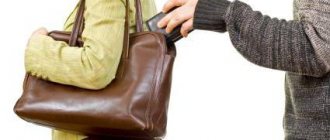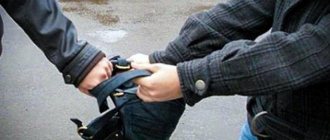Forensic characteristics of thefts. Circumstances to be established
Theft, i.e. secret theft of other people's property is among the most common crimes against property (Article 158 of the Criminal Code of the Russian Federation).
The most common thefts are from apartments, dachas, garages and other premises belonging to individual citizens, theft of personal belongings at stations and on trains, pickpocketing in markets, shops, public transport, and also on the streets. The direct objects of criminal attacks are money (including foreign currency), audio and video equipment, jewelry, clothing, cars, motorcycles, bicycles, and less often (in case of thefts from dachas) - household utensils and food. In recent years, theft of crops from fields and gardens has become widespread.
Thefts from shops, warehouses and other places where material assets are stored or sold are also often committed.
The methods of committing thefts are very diverse. They can be classified as follows:
- theft of state or public or personal property of citizens from premises; they can be committed both by breaking (criminals pick locks, press or knock down doors, expose windows) and without breaking (for example, by picking a key);
- theft of personal property of citizens not related to entry into premises (pickpocketing, theft from bags, including by cutting bags and pockets; fleecing drunks; theft of suitcases, bags and other things);
- thefts committed by breach of trust; Among them, a distinction is made between thefts with penetration into the premises, when the victim allows the thief into his apartment, and without penetration into the premises (a typical example is the so-called “assisted thefts” at train stations, when a passenger entrusts his property to an unfamiliar person and leaves for a short time);
- theft from automatic lockers;
- vehicle theft;
- theft from cars, etc.
Apartment burglaries most often occur during the day, when apartment owners are not at home; thefts not related to entry into premises - both in the morning and evening, and during the daytime. Pickpockets operate in crowded places (city transport, shops).
The traces left by criminals when committing thefts are very diverse and largely depend on the types of thefts and the methods of their commission. Thus, during thefts from premises and from cars, mainly material traces of the crime remain (burglary tools, hands, shoes, etc.). In the case of thefts committed by abuse of trust, on the contrary, intellectual traces predominate (victims, and sometimes witnesses, give a fairly complete description of the criminal’s appearance and usually confidently identify him). There are almost no traces left when committing thefts of personal property that are not associated with penetration into the premises (pickpocketing, thefts from automatic lockers). Sometimes it is possible to reveal them only with the help of operational investigative means and methods.
A significant part of thefts are committed by teenagers, as well as people who abuse alcohol and drugs in order to obtain the funds necessary for this. Criminals who commit theft by abuse of trust and, especially, pickpockets usually use meticulously developed techniques, which often allow them to commit dozens of crimes with impunity. It is typical that after returning from prison they again commit thefts using the same methods.
Among thieves, people with a low general educational level predominate. Many of them have been previously convicted, not only for theft, but also for other crimes.
The circumstances to be established during the investigation of thefts include: 1) whether theft took place; 2) time, place and conditions of its commission; 3) the item of theft (what was stolen by the criminal), its value, signs; 4) who owned the stolen property; 5) method of committing the theft; 6) the subject of the theft (who committed it); 7) whether the theft was committed by a criminal group, if so, the degree of guilt of each group member; place, time and method of selling stolen goods; 9) circumstances mitigating or aggravating the responsibility of the perpetrators; 10) the reasons and conditions that contributed to the theft.
2) time, place and conditions of its commission; 3) the item of theft (what was stolen by the criminal), its value, signs; 4) who owned the stolen property; 5) method of committing the theft; 6) the subject of the theft (who committed it); 7) whether the theft was committed by a criminal group, if so, the degree of guilt of each group member; place, time and method of selling stolen goods; 9) circumstances mitigating or aggravating the responsibility of the perpetrators; 10) the reasons and conditions that contributed to the theft.
I demand satisfaction!
In addition to dismissal (or other disciplinary action), the employee faces punishment in the form of compensation to the employer for direct actual damages. Lost income (lost profits) cannot be recovered from an employee (Article 238 of the Labor Code of the Russian Federation). In case of theft, embezzlement, or shortage, the amount of damage is determined based on inventory data.
For the damage caused, the employee bears financial liability within the limits of his average monthly earnings, unless otherwise provided by the Labor Code of the Russian Federation or other federal laws (Article 241 of the Labor Code of the Russian Federation), for example, upon dismissal due to loss of trust (if the employer did not contact law enforcement agencies with statement of theft).
If an employee is accused of theft or embezzlement, then he is assigned full financial responsibility (clause 5 of Article 243 of the Labor Code of the Russian Federation). However, the amount of stolen valuables that exceeds the average monthly salary can be recovered from the employee only through the court (Articles 242, 243 of the Labor Code of the Russian Federation).
To recover the amount of damage, the head of the organization must issue an order to withhold money within a month after the amount of damage is established (Article 248 of the Labor Code of the Russian Federation). You can deduct no more than 20% from an employee’s monthly salary. If deductions are made from an employee’s income according to executive documents, then their total amount should not exceed 50% of the salary (Article 138 of the Labor Code of the Russian Federation).
Elena Rakova
Features of tactics of initial investigative actions
During the inspection of the crime scene in cases of theft, one should strive to find out the following circumstances: what is the object from which the theft was committed, what are the surroundings and approaches to it; from which side the criminal entered the place of theft and in what direction did he escape (the criminal’s routes of approach and departure are examined); how the criminal got to the location of material assets (in what way, what technical means did he use); what actions and in what sequence were performed by the criminal; how many persons participated in the theft; what traces of criminal actions remained at the scene of the theft and what traces from the scene could remain on the criminal (his body, clothes, tools, stolen objects); Are there any characteristic signs in the tracks and on other material objects that can be used to determine the age, professional skills, appearance of the criminal, and his level of mastery of thieves’ techniques; are there any signs indicating a staged theft, etc.
To find out these circumstances, it is often necessary to inspect not only the premises from which the theft was committed, but also the adjacent rooms through which the criminal entered or left. It is advisable to inspect areas adjacent to the scene of the incident (for example, the territory of a store, warehouse, institution), since criminals may drop any objects there, leave or hide stolen property. It is also important to study the places from which the criminals conducted surveillance of the site of the alleged theft - “thieves’ intelligence.” In such places, exposed or broken window glass may be found that interfered with observation, with traces of hands or forehead prints; It is often possible to find traces of shoes, cigarette butts, etc. there.
Depending on the situation at the scene of the incident, the investigator chooses the most rational method of inspection. If entry into the premises was carried out by breaking into a barrier, the inspection should begin with an examination of the location of the break-in and the immediately adjacent areas of the premises, gradually moving to the center of the scene, i.e. use a concentric inspection method. In the case when the forensic center of the crime scene is located in the depths of the room (for example, a broken safe or a wardrobe from which clothes were stolen), it is advisable to carry out the inspection in a concentric or combined way - first inspect the safe or wardrobe, then the front door (if even on it there are no signs of a break-in, it is possible that someone entered the room using a selected or counterfeit key or master key) and continue the inspection, moving along the perimeter of the walls and gradually approaching the geometric center.
It is advisable to look for traces in places of entry into the object (for example, a door squeezed out with a jack, a broken window), as well as on the surfaces of opened or damaged storage areas for stolen goods. On doors, windows and adjacent surfaces, traces of hands, shoes, clothing fibers, traces of burglary tools may be found, on the floor - cigarette butts, drops of blood (if the criminal was injured), soil particles, sometimes stains of saliva and other secretions of the human body. In addition to traditional traces, scent traces can be taken from objects that the criminal allegedly touched.
When burglary tools are found at the scene of an incident, their careful examination often makes it possible to detect traces of the criminal’s hands, and sometimes the initials or surname of the owner, roughly establish his profession, hobbies (for example, wire cutters used to disable alarms, if they have handles protected by plastic or rubber, may belong to an electrician, TV repairman, etc.).
When inspecting incident sites in stores, warehouses, and catering establishments, it is necessary to pay attention to signs characteristic of a staged theft. These include: the presence of traces indicating that the locks were broken in another place and with the mechanism in an unlocked position; that the barrier was broken from inside the premises and the thieves are familiar with the features of the premises and the places where valuables are stored; excessive, logically difficult to explain, numerous damage to the barrier and things in the room; disorder inside the premises inappropriate to the circumstances of the theft; the absence of only particularly valuable items stored in secluded places; discrepancy between the size of the stolen items and the size of the breach, etc.
When interrogating victims and financially responsible persons in cases of theft, it usually becomes clear: what was stolen, the quantity of stolen items, signs of individual items; where the stolen property was located; if money is stolen, then in what bills; when and from whom did the theft become known; whether this object was protected, what is the procedure for protection; whether the object (shop, apartment) was blocked by a security alarm, whether it is working; what locks, bolts, and bolts were used to close the doors and windows of the facility; who may be suspected of committing theft; whether the situation at the scene of the incident had changed before the arrival of the investigative team, if it had changed, then for what purpose, what exactly had been changed, etc.
When interrogating, you should strive to provide as much detail as possible in your testimony. The signs and characteristics of the stolen property should be especially fully described. In addition to a detailed description of the stolen property in the protocol, you should find out whether the interrogated person can provide documents for the stolen property (passport, warranty card) or accessories to the items (spare buttons, a piece of fabric from which a suit or coat is made). If the criminals stole the victim's clothes, it is necessary to find out what was in her pockets.
If a theft has been committed through abuse of trust, it is advisable to obtain maximum information about the stolen things, about the criminal, his appearance, characteristics of behavior, speech and clothing, and what he said about himself.
When interrogating witnesses - eyewitnesses of a crime, data is established about the appearance of the suspect, the time and method of committing the theft; traces or objects left by criminals at the crime scene; stolen items, their individual characteristics; the direction in which the criminals fled, the vehicles they used.
During the arrest, the actions of the criminal should be carefully monitored. Typically, thieves try to throw away incriminating items and valuables or transfer them to accomplices. There is a specificity in detaining pickpockets, whom police officers often take to the duty station without giving them the opportunity to unclench their fist with the “loot”; this circumstance must certainly be reflected in the arrest report.
During a personal search, special attention should be paid to items related to the nature of the crime or similar crimes committed. In particular, the fact that a person detained for theft was found in possession of several wristwatches, sets of keys or master keys, safety razor blades, documents not belonging to the detainee, and other similar items is usually of great importance.
The purpose of a search of premises in cases of theft is to locate the stolen property; items that could be used as burglary tools; clothing that clearly does not suit the suspect and his family members, etc. Not only residential premises are subject to search, but also utility rooms - sheds, attics, garages, where it is sometimes possible to find items of little value, but very important for the investigation. In particular, in cases of theft from tents, shops, bases, warehouses, it is sometimes possible to find labels, labels, as well as wrapping paper and other packaging materials.
The discovered hiding places must be photographed, described in the protocol and marked on the plan of the room being searched.
The examination and inspection of the suspect’s clothing may have important evidentiary value. If the theft is committed by breaking into a wall or ceiling, then particles of the broken barrier (plaster, lime, brick dust, etc.) may be found on the clothes, shoes, headdress or in the hair of the detainee. This allows you to refute the alibi put forward by the defendant.
If the detainee has committed theft from an object on which a chemical trap was installed, which was activated at the time of the theft, it is useful to use an ultraviolet illuminator during the examination; the characteristic glow of the suspect's hands and clothing is reflected in the protocol. Items of clothing with traces of the chemical substance are included in the case. Subsequently, with the help of forensic chemical examination, the homogeneity of the relevant chemical substances is established.
If a person suspected of theft is detained at the scene of a crime or in hot pursuit, during the interrogation of the suspect all the circumstances of the crime are clarified (when and how the theft was committed; who, besides the suspect, participated in the crime; what exactly was stolen; signs of the stolen things; if the things sold - to whom, under what circumstances, for what price, etc.).
Typically, the suspect denies involvement in the theft and states that he was in a different location at the time of the crime. In such cases, he is asked to tell in detail where he was at that time, what he was doing, and who can confirm his testimony. Unmasking a suspect's false alibi can be critical to an investigation.
Pickpocketing - features, investigation methods, protection against theft
To minimize becoming a victim of pickpocketing, it is recommended: - do not keep all important and valuable things in your wallet, many people store there not only money and credit cards, but also a passport and driver's license: - try to take with you approximately the amount you need, if you need a large amount of cash, hide it in different pockets and preferably in the inner ones; — internal pockets are the best places for storage, the pocket should fit snugly to the body so that you can feel it; - when you are in transport, always hold your bag close to you; if you sit down, place it on your knees in front of you; - often pickpockets steal from bags, not pockets, so do not carry valuables in bags; if you have to keep your wallet in a bag, then do not put it on top.
It is worth remembering the peculiarity of this type of theft - pickpockets almost always act in a small group, the group works clearly, everyone is responsible for their duties. One looks after those around him and is necessary to warn of danger, the second accepts stolen goods and disappears from the crowd, and the third can create a wall for others, giving extra time to his “comrade” to commit the theft.
Features of the investigation of pickpocketing and theft from hand luggage
Cases of pickpocketing are usually initiated as a result of the arrest of a criminal red-handed or at the request of the victim when the criminal managed to escape. The greatest difficulties arise in the investigation of thefts initiated at the request of the victim when the criminal has disappeared.
In these cases, operational investigation and investigative actions to identify and detain the criminal become of primary importance; the initial measure is the interrogation of the victim. During which information is obtained about the stolen valuables, the time, place and method of the theft, and suspects. When clarifying the circumstances preceding the theft, attention is paid to the moments when the victim was in the crowd, when he was distracted. The victim must be interrogated in detail about the signs of the suspect’s appearance: face, clothing. It is advisable to present a photo album with photographs of persons who may be involved in pickpocketing. The circle of suspects may be limited to studying the method of its commission, by which software workers can identify the criminal. If there are reasonable suspicions against a certain person, he is subject to detention and a personal search. A personal search must be combined with an interview about the amount of money on him and the contents of documents. The detection of special devices for committing thefts and things belonging to different persons (wallets, passports, etc.) is of incriminating significance. A search of the detainee's apartment may also lead to the discovery of similar evidence. The detainee is fingerprinted and checked against records. An inspection of the crime scene is always carried out when a pickpocketing site has been established. Here the criminal could throw away stolen or incriminating things and leave traces of his presence. If abandoned items are found, they are checked to see if there are fingerprints on them, and a fingerprint examination is ordered. If necessary, police officers who participated in the arrest, store and transport service employees are questioned about the behavior of the accused at the scene of the theft. As well as interrogations of neighbors, colleagues, etc. the accused about his lifestyle, connections, etc.
We recommend reading: Pregnant Women's Worry During Theft








